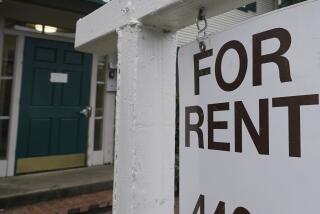THE EVICTION MAN : Commercial Ousters Are Up 30% in Year
- Share via
A sure sign of hard times: The wolf at the door is acting more like a sheep.
Craig Doolittle portrays himself as practically a lamb. A former policeman, he specializes in evicting commercial and residential tenants for landlords as general manager of AAA Lessor Services in Pasadena.
He’s still tough when he has to be, but as times get worse, the operative concept becomes “rehabilitate” rather than evict. So Doolittle increasingly finds himself acting as a mediator between cash-strapped tenants who need breathing room and landlords who must keep the cash flowing to pay their banks and investors.
A stack of papers for 20 eviction proceedings fills a basket in his office, testimony to the financial strain many people are under.
“They have no savings to fall back on,” he says. “All it takes is some little thing to completely shake them. And the biggest thing they have to pay each month is the rent.”
Doolittle says he sympathizes with many of 100 cases a month the office handles. He and his wife bring canned goods on holidays to the family of one Pasadena restaurant worker he has evicted five times.
The fastest-growing trend is in commercial evictions, Doolittle says, up 30% from a year earlier. Typically, the business involved is a small one--liquor stores, sandwich shops, clothiers--in one of the mini-malls that proliferated on Southern California street corners in the 1980s.
Two years ago, instructions from property owners usually were simple: Get rid of a tenant who doesn’t pay.
Now, Doolittle says, about one in five cases are negotiated. Owners and managers of apartments, office buildings and small shopping centers are more open to working out a plan with tenants who are behind. What usually results is an agreement in which the tenant gets some breathing room but agrees to a court-enforced promise to make up the back rent later.
It’s not altruism causing the change, but the real-estate market. Having a tenant who pays something is better than two of the more common alternatives these days: costly eviction proceedings while no rent comes in or having empty space in a tough leasing market.
“We’re more open to reason now,” Doolittle says.
Not every landlord wants to talk it over. The flurry of foreign investment in Southern California in the 1980s means that Doolittle communicates with many overseas landlords only by fax. Many, he says, are reluctant to negotiate and just want to get problem tenants out.
Many tenants are increasingly uncooperative too. One heir to a family business fortune who was behind on his $5,000-a-month rent for a Beverly Hills home avoided Doolittle’s attempts to serve him with papers by hiding behind the house’s elaborate security system, including guard dogs.
So Doolittle borrowed a limousine and went to the home in a driver’s uniform. He told the tenant--over the house’s intercom--that his limousine had arrived. When the man said he never ordered one, Doolittle responded by speculating that the man’s friends were playing a practical joke, adding that he needed the man’s signature to show he never ordered the limo. When the man emerged from the house, Doolittle served him.
Then there is the guy who told Doolittle a tear-jerking story of spending his rent money to have his son’s leg amputated because of gangrene.
A suspicious Doolittle offered to send flowers, but the man balked, saying his son was out of the hospital now. Not much later, the man’s roommate told Doolittle that the man had no children.
More to Read
Inside the business of entertainment
The Wide Shot brings you news, analysis and insights on everything from streaming wars to production — and what it all means for the future.
You may occasionally receive promotional content from the Los Angeles Times.










